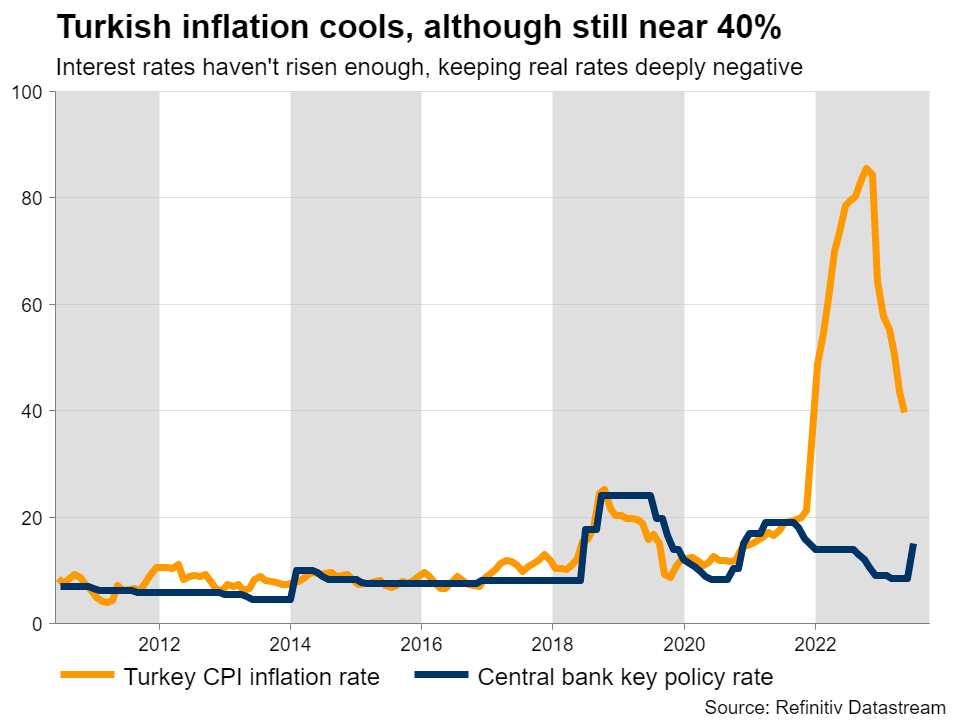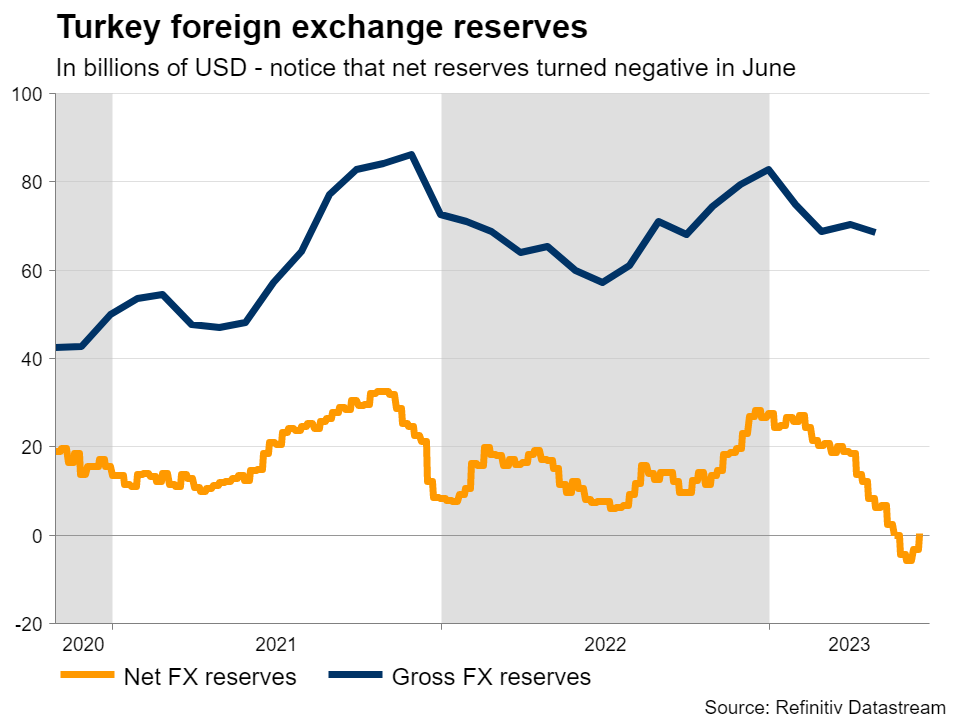Turkish lira falls apart, what can turn the tide?
 That’s only half the story, though. Another element that ravaged the lira was the central bank’s latest decision on interest rates. With a new governor coming in, there was rampant speculation about a massive increase in rates to fight runaway inflation. Some economists expected rates to be raised immediately to 25%, so when the central bank only lifted them to 15%, investors saw that as a huge disappointment. With inflation running around 40%, this move was seen as a ‘half measure’ that won’t be sufficient in cooling the economy down. Behind the downtrendTaking a step back, the lira’s downtrend is not a new phenomenon. The currency has been in decline for more than two decades, although the losses accelerated sharply after 2018 as inflation started to fire up and the nation’s deficits blew up. When inflation moves far higher but interest rates don’t follow suit, the result is that real interest rates fall deep into negative territory. That’s toxic for the lira because it discourages investors and consumers from holding it. Nobody wants to keep a currency that is constantly losing its value, if they are not compensated through high interest rates.
That’s only half the story, though. Another element that ravaged the lira was the central bank’s latest decision on interest rates. With a new governor coming in, there was rampant speculation about a massive increase in rates to fight runaway inflation. Some economists expected rates to be raised immediately to 25%, so when the central bank only lifted them to 15%, investors saw that as a huge disappointment. With inflation running around 40%, this move was seen as a ‘half measure’ that won’t be sufficient in cooling the economy down. Behind the downtrendTaking a step back, the lira’s downtrend is not a new phenomenon. The currency has been in decline for more than two decades, although the losses accelerated sharply after 2018 as inflation started to fire up and the nation’s deficits blew up. When inflation moves far higher but interest rates don’t follow suit, the result is that real interest rates fall deep into negative territory. That’s toxic for the lira because it discourages investors and consumers from holding it. Nobody wants to keep a currency that is constantly losing its value, if they are not compensated through high interest rates.  Many have attributed the central bank’s reluctance to raise rates to political pressure from President Erdogan, who has characterized high interest rates as “the mother and father of all evil”. The fact the central bank has changed its Governor four times over the last five years is a testament to this political arm-twisting, as Erdogan simply replaced any leaders that dared to raise rates much. Therefore, it can be argued the central bank has effectively lost its independence, leaving it unable to take the actions necessary to extinguish inflation. Even the new governor - who has a background as a Wall Street banker - could not break this spell. Making matters worse for the lira, Turkey runs a chronic current account deficit, which has swelled in recent years. That means the nation is a net-borrower, importing more than it exports and relying on capital flows from abroad to finance the difference. Over time, these deficits can exert massive downward pressure on a currency, especially if they keep widening.
Many have attributed the central bank’s reluctance to raise rates to political pressure from President Erdogan, who has characterized high interest rates as “the mother and father of all evil”. The fact the central bank has changed its Governor four times over the last five years is a testament to this political arm-twisting, as Erdogan simply replaced any leaders that dared to raise rates much. Therefore, it can be argued the central bank has effectively lost its independence, leaving it unable to take the actions necessary to extinguish inflation. Even the new governor - who has a background as a Wall Street banker - could not break this spell. Making matters worse for the lira, Turkey runs a chronic current account deficit, which has swelled in recent years. That means the nation is a net-borrower, importing more than it exports and relying on capital flows from abroad to finance the difference. Over time, these deficits can exert massive downward pressure on a currency, especially if they keep widening.  The government has tried all sorts of unconventional tactics to stop the lira’s bleeding, such as making it more difficult to short the currency, introducing special savings accounts that compensate consumers if the lira falls sharply, and de facto confiscating foreign currencies from private banks to boost its FX reserves. These moves helped slow down the pace of depreciation for some time, alongside regular FX interventions, albeit at the cost of draining reserves. What’s next Looking ahead, there isn’t much that can turn the tides in the lira. What the currency desperately needs are higher interest rates, to slow down nominal growth and eradicate inflationary pressures, a painful process that will most likely involve a recession. Yet, President Erdogan seems determined not to let that happen. Slashing government spending could help to lower inflation, although this strategy might still be bearish for the lira initially, given its negative implications for economic growth. Plus, fiscal austerity would be a wildly unpopular move politically, making it seem even less likely.
The government has tried all sorts of unconventional tactics to stop the lira’s bleeding, such as making it more difficult to short the currency, introducing special savings accounts that compensate consumers if the lira falls sharply, and de facto confiscating foreign currencies from private banks to boost its FX reserves. These moves helped slow down the pace of depreciation for some time, alongside regular FX interventions, albeit at the cost of draining reserves. What’s next Looking ahead, there isn’t much that can turn the tides in the lira. What the currency desperately needs are higher interest rates, to slow down nominal growth and eradicate inflationary pressures, a painful process that will most likely involve a recession. Yet, President Erdogan seems determined not to let that happen. Slashing government spending could help to lower inflation, although this strategy might still be bearish for the lira initially, given its negative implications for economic growth. Plus, fiscal austerity would be a wildly unpopular move politically, making it seem even less likely.  That leaves structural reforms and regulatory changes, but admittedly, it’s highly doubtful any such policies would be powerful enough to rescue the currency. If there were easy solutions from a legislative perspective, they would have been implemented already. As such, it’s difficult to see a path towards a sustainable FX recovery, at least under the current political leadership. While a near-term correction seems plausible after such a dramatic downfall, it is unlikely to go very far, with real rates so deep in negative territory and FX reserves exhausted.
That leaves structural reforms and regulatory changes, but admittedly, it’s highly doubtful any such policies would be powerful enough to rescue the currency. If there were easy solutions from a legislative perspective, they would have been implemented already. As such, it’s difficult to see a path towards a sustainable FX recovery, at least under the current political leadership. While a near-term correction seems plausible after such a dramatic downfall, it is unlikely to go very far, with real rates so deep in negative territory and FX reserves exhausted. संबंधित परिसंपत्तियाँ
ताजातरीन समाचार
अस्वीकरण: XM Group के सत्व केवल निष्पादन वाली सेवा और हमारी ऑनलाइन व्यापार सुविधा में पहुँच प्रदान करते हैं, ताकि व्यक्ति वेबसाइट पर या उसके जरिए उपलब्ध सामग्री को देख सके और/या उसका उपयोग कर सके। इसका प्रयोजन इसे बदलना या विस्तार देना नहीं है, न ही वह इसे बदलता या विस्तार देता है। इस तरह की पहुँच हमेशा ही निम्नलिखित के अधीन रहेगी: (1) नियम और शर्तें; (2) जोखिम चेतावनियाँ; और (3) पूर्ण अस्वीकरण। इसलिए ऐसी जानकारी सामान्य सूचना से अधिक कुछ भी नहीं है। विशेष रूप से, कृपया इससे अवगत रहें कि हमारी ऑनलाइन व्यापार सुविधा की सामग्रियाँ न तो किसी चीज का अनुरोध करती हैं, न ही वित्तीय बाजारों में प्रवेश करने की पेशकश ही करती हैं। किसी भी वित्तीय बाजार में व्यापार करने के साथ आपकी पूँजी को उल्लेखनीय जोखिम है।
हमारी ऑनलाइन व्यापार सुविधा में प्रकाशित सभी सामग्रियाँ शैक्षणिक/सूचनात्मक प्रयोजनों मात्र के लिए हैं, और इनमें वित्तीय, निवेश टैक्स या व्यापार सलाह और सुझाव नहीं हैं - न ही ऐसा समझना चाहिए कि इनमें ये सब हैं; न ही इनमें हमारी व्यापार कीमतों का अभिलेख है; न ही इनमें किसी वित्तीय उपकरण में लेन-देन करने का निमंत्रण या अनुरोध है; न ही ये आपको अवांछित वित्तयी प्रोमोशन पेश करती हैं।
इस वेबसाइट में मौजूद कोई भी तृतीय पक्षीय सामग्री, तथा XM द्वारा तैयार की गई सामग्रियाँ, जैसे: अभिप्राय, समाचार, अनुसंधान, विश्लेषण, कीमतें और अन्य सूचनाएँ या तृतीय पक्षों की साइटों के लिंक, "जैसा-है-वैसा" के आधार पर बाजार के बारे में सामान्य टिप्पणी के रूप में उपलब्ध कराई गई हैं, और वे निवेश हेतु सलाह नहीं हैं। जिस हद तक कीसी सामग्री को निवेश अनुसंधान मान लिया जाता है, उस हद तक आपको ध्यान में रखना होगा और इसे स्वीकार करना होगा कि वह सामग्री इस उद्देश्य से और निवेश अनुसंधान की स्वतंत्रता को बढ़ावा देने के लिए कानूनी आवश्यकताओं के मुताबिक, तैयार नहीं की गई है, और इसलिए उसे प्रासंगिक कानूनों और विनियमों के तहत विपणन संप्रेषण माना जाएगा। कृपया सुनिश्चित करें कि आपने गैर-आश्रित निवेश के बारे में हमारी सूचना को पढ़ और समझ लिया है। पीछे दी गई जानकारी के बारे में अनुसंधान और जोखिम चेतावनी यहाँ उपलब्ध है।